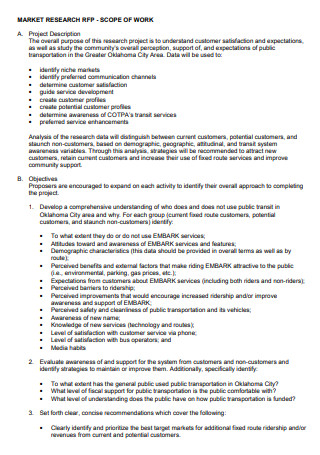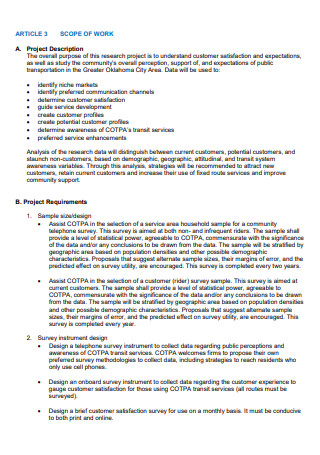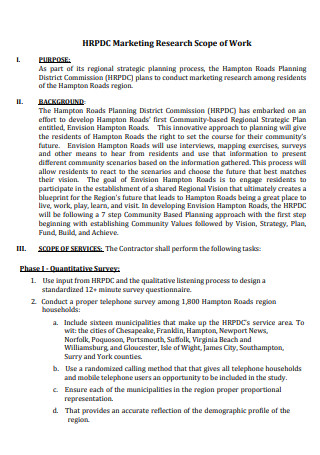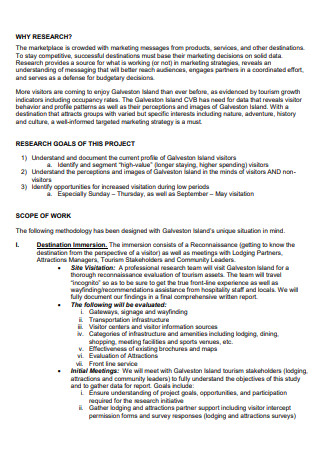5+ Sample Market Research Scope of Work
-

Market Research Scope of Work Template
download now -

Basic Market Research Scope of Work
download now -

Marketing Research Scope of Work Example
download now -

Market Research Proposed Scope of Work
download now -

Printable Market Research Scope of Work
download now -

Market Research Scope of Work in PDF
download now
FREE Market Research Scope of Work s to Download
5+ Sample Market Research Scope of Work
What Is a Market Research Scope of Work?
Benefits of Market Research
The Formula of Market Research
How to Develop a Research Plan
FAQs
What is the marketing scope and nature?
What is the marketing research nature?
What are marketing tasks?
What Is a Market Research Scope of Work?
The job that has to be done, how it will be done, who will perform it, and what results can be expected are all included in the scope of work. These include the deliverables and the steps for completing them. Research on consumers, products, sales, distribution, advertising, pricing, and sales forecasting are all included in market research. This would also involve determining consumer requirements, wants, and customer satisfaction. This research is typically carried out internally by the business or a third-party market research firm. Market researchers are the names of those businesses that specialize in this industry. Work in this profession can vary based on the project, trade, or industry. According to statistics, market research analysts’ employment is expected to increase by 22%, which is faster than the average for all occupations.
Benefits of Market Research
Consumer sees promotion for a product that appears ideal for them and delights in their good fortune; yet, this scenario likely did not result from luck and should not have. Through strategic market research, businesses make these situations conceivable. With relevant knowledge of its target market, a company can build products and marketing strategies that directly appeal to consumers. And the advantages do not end there. There are numerous methods in which you may use market research data to catapult your business to success. Market research can provide significant benefits to businesses like yours. Let’s examine some of the most effective market research methods to facilitate your business’s success.
The Formula of Market Research
After developing your marketing plan, you should use the “Five P Formula” to review and reevaluate your business actions on an ongoing basis. These seven components include product, price, promotion, location, packaging, and positioning. As products, markets, consumers, and demands change swiftly, you must evaluate these five Ps frequently to ensure you are on track and gaining the best possible results in today’s market.
1. Product
Develop the habit of evaluating your product as if you were an outside marketing consultant hired to assist your firm in determining whether it is in the right business at this time. Ask important questions such as, “Is your existing product or service, or product and service combination, acceptable for the market and customers today?” When you cannot sell as many of your products or services as you want, you must cultivate the practice of evaluating your business honestly and asking, “Are these the proper items or services for our clients today?” Is there a product or service you currently provide that, knowing what you do now, you would not offer again? Is your product or service significantly superior to anything else on the market compared to that of your competitors? Moreover, what is it? If not, are you able to create an area of superiority? Should you even be selling this product or service in today’s market?
2. Prices
Price is the second P in the formula. Develop the habit of continually reevaluating the prices of the goods and services you offer to ensure that they still reflect the reality of the current market. Occasionally, it would help if you reduced your prices. Sometimes, it may be prudent to increase your prices. Numerous businesses have discovered that the profitability of specific products or services does not justify the time and resources required to produce them. They may lose some clients if they raise their pricing, but the remaining customers make a profit on every sale. Would this be suitable for you? Occasionally, you must modify your terms and conditions of sale. Sometimes, by extending your price across several months or years, you can sell significantly more than you are currently, and the interest you can charge will more than compensate for the delay in cash receipts. Sometimes it is possible to combine products and services with special deals and promotions. Occasionally, you can incorporate complimentary extras that are inexpensive to produce but make your costs appear much more desirable to clients. As in nature, if you encounter resistance or irritation in any aspect of your sales or marketing plan, you should be willing to revisit that area. Consider that your present pricing structure may not be optimal for the current market. Be ready to alter your prices, if necessary, to remain competitive and to survive and prosper in a rapidly changing market.
3. Promotion
The third practice in marketing and sales is always to consider promotion. Promotion encompasses all your methods to inform people about your products or services and your marketing and sales strategies. Minor adjustments to market and sell your items can significantly impact your outcomes. Even minor adjustments to your advertising can result in rapid revenue increases. Simply by altering the advertisement’s headline, skilled copywriters can frequently raise the advertising’s response rate by 500 percent. Large and small businesses in every industry regularly test new advertising, marketing, and sales techniques. And now for the rule: Whatever marketing and sales approach you to employ now will eventually become ineffective. Sometimes it will cease operating for known causes, and sometimes it will stop working for unknown ones. In either situation, your marketing and sales practices will eventually become ineffective, necessitating the development of new sales, marketing, and advertising approaches, products, and strategies.
4. Place
The fourth marketing mix is where your product or service is sold. Make it a habit to look at and think about where the customer meets the salesperson. Changes in place can sometimes cause sales to go up quickly. There are many areas where you can market your product. Some companies use direct selling, sending salespeople to meet and talk with prospects. Some deal together with other businesses that offer similar goods or services. Some companies use salespeople or distributors who work for the manufacturer. Many companies employ more than one of these methods at the same time. In each case, the business owner must decide where the customer can find the essential information about the product or service they need to buy.
5. Packaging
Packaging is the fifth element of the marketing mix. Develop the habit of examining every visual piece of your product or service’s packaging through the eyes of a skeptical prospect. Remember that consumers establish their first impression of you or your organization within the first thirty seconds of meeting you or a representative of your business. Minor modifications to the packaging or outward appearance of a product or service can frequently elicit radically different responses from clients. Regarding the packaging of your organization, product, or service, you should consider everything the customer sees with your company through the purchasing process. Packaging relates to the exterior appearance of your goods or service. Packaging also relates to how your employees are dressed and groomed. It includes your offices, waiting areas, brochures, communications, and other visual aspects of your organization. Everything matters. Everything aids or hinders. Everything influences a customer’s confidence in doing business with you.
How to Develop a Research Plan
Here, we examine the second phase of market research: creating an overall research plan. It is one of the more complicated phases due to its multiple separate components. A research plan component determines who can supply the most pertinent information regarding the research questions and alternative business decisions. This activity requires developing a sampling plan to ensure that the acquired data is representative of the entire target population. The procedures involved in identifying and getting a sample are usually called the sampling plan. A sample unit is the group of possible study participants or responders from which the sampling frame will be built, and ultimately, the sample will be drawn. Appropriate sample procedures are essential for achieving accurate market research results. Following the six steps of the market research procedure will guarantee that your market research yields practical customer insights.
1. Establish a Sampling Area
The initial choice a market researcher must make is the selection of the sampling frame. To complete this phase, the market researcher must identify the target demographic. They must respond to the inquiry, “Who will engage in the study?” From the sampling unit, a sampling frame is constructed, the primary goal of which is to ensure that each member of the target people has an equal probability of being sampled. This is not a need for qualitative research, as the “equal chance” criterion only applies to evidence-based research in which a theory is being tested.
2. Determine the Sample Size
The second choice the market researcher must make pertains to the sample size. How many individuals will participate in the study? In quantitative research, the objective is to obtain a representative sample of the target population, which can be achieved most effectively by considering sample size, confidence levels, and confidence intervals. In quantitative research projects, the more significant the sample size, the more reliable the study findings will be, and the more the results can be extended to the target population. The rule of thumb is that fewer than one percent of the target population must engage in a research project for a sample to be reliable. The condition is that the sampling technique must be credible and done with rigor.
3. Select a Sampling Method
There are two primary sampling methods: probabilistic and non-probabilistic. Like qualitative and quantitative research, probability and non-probability sampling processes have proponents and detractors. A researcher draws a chance sample from the target population for a quantitative study to calculate specific statistical factors. The probability sample indicates the sampling error-related confidence levels or confidence limits. Probabilistic sampling can burden resources, such as time, money, and skill, but it permits market researchers to assess sample error. Non-probability sampling techniques can yield precious data and, ultimately, market insights. Different methodologies and approaches will generate additional data types, and the sample procedures must correspond to the data required to respond to the study objectives.
4. Get Participant Consent
After developing a prospective sampling strategy and establishing the sampling frame, market researchers must choose the most effective means of contacting and communicating with the participant group that looks to be the best fit for the research project. First, the potential participants must agree to engage in the study, and second, their participation must be contingent on their comfort with the research circumstances and their informed consent.
FAQs
What is the marketing scope and nature?
The conduct of business operations directs the flow of goods and services from producer to customer or user. Marketing is an evolving procedure. A sequence of interdependent functions: Marketing is a continual, complex, and interconnected process. Continuous planning, implementation, and management are required.
What is the marketing research nature?
Marketing research is one of the essential methods for answering issues since it: Connects consumers, customers, and the general public to the market through data used to identify and define marketing. Develops, improves, and assesses marketing efforts.
What are marketing tasks?
Marketing tasks are the individual, low-level jobs performed by the marketing department or individual marketers. This includes purchasing and selling, educating the public about the commodity, and arranging the flow of value through intermediaries who facilitate operations.
A well-written market research job scope facilitates agreement between partners on terms, conditions, needs, and project goals. Each element should be comprehensive, minimizing uncertainty and service-related concerns in the future interaction between a firm and a market researcher. An adequate market research scope of work would be a great advantage to a corporate organization, as it would act as a springboard for creating an effective marketing plan for their products and services and achieving their objectives.
